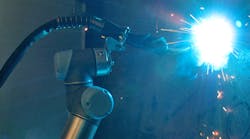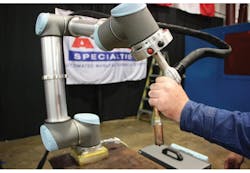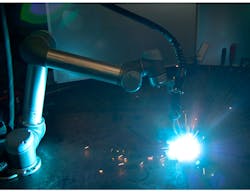The chief benefit offered by collaborative robots (cobots) is their ability to operate without a cage. The inherent safety features built into the robots allows them to safely operate near human operators. And cobots are unquestionably on the rise: BIS Research reports that from 2015 to 2021, the collaborative robot market is expected to grow to approximately $2 billion and 150,000 units.
The next logical step for cobots is to start tackling the tasks handled by industrial robots. This involves heavy assembly and more delicate tasks like welding. Welding is especially in demand at the moment, as many skilled workers are retiring and not being replaced. The American Welding Society updated its forecast this year, predicting an estimated shortage of 372,000 welders by 2026. Thus, it should come as no surprise that Universal Robots (UR), working together with ARC Specialties, recently introduced a new attachment to its UR+ line that offers welding capabilities.
At next month’s Fabtech show in Chicago, engineers will be able to see the fruit of the two companies’ collaboration. The SnapWeld Collaborative Robot Welding package consists of a Profax wire feeder and a water-cooled torch enabling which can weld up to 600 amps—featuring a torch bracket, cables, and hoses. The package integrates directly into the UR+ platform. At FabTech, users will be able to perform stitch welding by teaching the robot its beginning and end points using position recording or console programming, including the number and length of the stitch weld. The robot with the SnapWeld attachment will move along the start and stop path of the desired weld, welding only the specified stitch areas. The video below shows the robot welding in action.
According to Craig Tomita of Universal Robots, welding has been a desired feature for UR users for a long time. “We are getting a lot of requests for integrating Universal Robots in welding booths,” explained Tomita. “So we saw this as a unique opportunity to develop an integrated, low-cost system for gas metal arc welding applications that no one else in the market is currently offering.”
The UR+ kit is ideal for welding. The settings include features such as wire feed speed and burn back time, gas flow time, and crater fill time with instant feedback on welding volts and amps. As Martin noted, “[The] UR+ welding package is the perfect solution for low volume/high mix fabrication shops, allowing operators to manage robot programs and welding parameters on the fly.”



